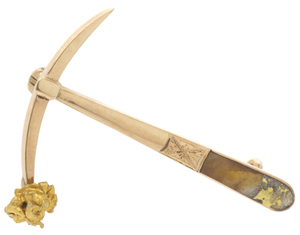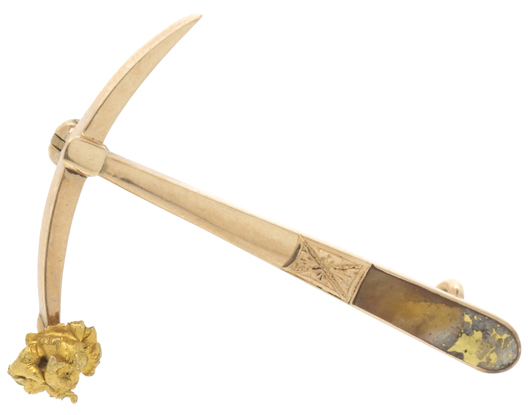
BEACHWOOD, Ohio – Jewelry has been worn for centuries as “totems,” religious or good luck pieces, or just to add beauty and color to an outfit. Brooches, often called “pins,” were made in many sizes and shapes. At first they were made of gold and precious stones to show the wearer’s wealth, but by the 17th century, imitation jewelry made of glass, faux pearls and gold-colored metal made it possible for the not-so-rich to own a pin. Designers made jewelry in the fashion of the day, from Victorian cameos to Art Nouveau enameled women in flowing gowns.
Often women chose a pin that represented something in her life. Madeline Albright, the former U.S. Secretary of State (1996-2001), became known for her pins. She wore an eagle for patriotic meetings, a snake when she distrusted her visitor, a bee-shaped pin when angry and zebras when she met with South Africans. Many pins have been designed to express a personal thought: a typewriter for a writer, an apple for a schoolteacher, a ballet dancer for a performer. Designers made solid gold tigers with diamonds or copies with rhinestones.
Did a prospector for gold or the owner of a gold mine order a pin sold recently that looked like a small pickax with a real gold nugget? It is made of rose gold and has added engraved designs. It was owned by someone in Colorado who sent it to Leslie Hindman Auctioneers in Chicago to be sold. An Australian bid and got it for $1,600.
Q: I have an old table brought here from Germany years ago. There is a mark on the bottom that says “Kiel Furniture Co.” Can you tell me anything about the maker?
A: Stories about things handed down in a family don’t always turn out to be true. Your table didn’t come from Germany; it was made in Wisconsin. Kiel Manufacturing Co. was founded in Milwaukee in 1892. There were many German cabinetmakers in the area and an ample supply of lumber from Wisconsin forests. The name of the company was changed to Kiel Furniture Co. in 1907, so your table was made after the name change. The company also operated a factory in Milwaukee from 1910 to 1932. The name of the company became A.A. Laun Furniture Co. in 1932. It is still in business.
Q: I acquired a kerosene lamp in Utah last year. It seems to be brass and has a metal plate with the words, “Property of Pony Express Station No. 9.” What can you tell me about it?
A: The metal plate on your lamp is probably a fake. Many fake and fantasy maker or owner tags are showing up on oil lamps, lanterns and locks to suggest a connection that makes them more attractive to collectors. The oil lamps and other items themselves also are probably fakes or reproductions from India or China. The most common of these fake tags are small, brass rectangular plates with simple, nondescript lettering. The plates advertise real or fictitious companies—railroads, delivery companies and even prisons—that are desirable to collectors interested in Wild West memorabilia or railroadiana. Pony Express and Wells Fargo are two of the most often referenced. The items may be nice collectibles, just don’t expect them to be real.
Q: I have a toy gun that looks like a cap pistol but is molded from solid metal. It has no moving parts. It weighs 3 1/2 pounds and has the word “Stallion” stamped on each side. I would like to know what it was made for since I don’t think a child would play with it.
A: Cap guns were popular toys in the 1950s and ’60s during the heyday of TV and movie Westerns. Nichols Industries was founded by Talley and Lewis Nichols in Pasadena, Tex., in 1946 and became one of the largest manufacturers of cap guns in the world. The company made a series of “Stallion” cap guns in various sizes with different model numbers from 1950 to 1961. The first one, the Stallion 45, was the “Toy of the Year” in 1950. They were made to look like the Colt 45 Peacemaker and had a revolving cylinder. Smoke came out of the barrel when the “bullets” were fired. Since your gun is relatively heavy and doesn’t have moving parts or shoot caps, it may have been a reproduction piece made as a paperweight or display item. Nichols Industries moved to Jacksonville, Tex., in 1954. It was sold to Kusan in 1965 and became Nichols Kusan. The company continued to make many of the Nichols cap gun models.
Q: I have an old safe. It’s 47 inches high by 32 inches wide by 27 inches deep and stands 8 inches off the floor on wheels. The door, which has a combination lock, reads “Barnes Safe & Lock Co., Greensburg, Pa.” There is a gold band painted on the door edge and decorations in the corners. The safe has an inner door with key lock and interior compartments. When was this safe made? Value?
A: In 1845 Thomas Barnes, a blacksmith, and his brother-in-law, Edmund Burke, a locksmith, established the Burke & Barnes Safe Manufacturers Co. in Pittsburgh. The company made iron cellar doors, grillwork and strong boxes. After the great Pittsburgh fire of 1845, Burke & Barnes experimented with designs for a fireproof safe. Soon after the Civil War, Barnes perfected a seven-flange door safe, which became world famous as the best protection against fire ever invented. Burke retired in the early 1870s and the company name was changed to Barnes Safe & Lock Co. In 1914 the company built a main shop, a filing room and a carpenter’s shop in Greensburg, Pa. It made safes, bank deposit boxes and fireproof chests until the 1920s. Your safe was made between 1914 and the early 1920s. Barnes safes have sold for $300 up to about $500. The value depends on condition.
Tip: Wicker can be vacuumed carefully or dusted. Then mix soap—not detergent—and water to make suds and wipe the chair with the suds to clean it. If you find any breaks unraveling, try to have the wicker fixed immediately to avoid future damage.
Terry Kovel answers as many questions as possible through the column. By sending a letter with a question, you give full permission for use in the column or any other Kovel forum. Names, addresses or email addresses will not be published. We cannot guarantee the return of any photograph, but if a stamped envelope is included, we will try. The volume of mail makes personal answers or appraisals impossible. Write to Kovels, Auction Central News, King Features Syndicate, 300 W. 57th St., New York, NY 10019.
CURRENT PRICES
Current prices are recorded from antiques shows, flea markets, sales and auctions throughout the United States. Prices vary in different locations because of local economic conditions.
- Red Wing vase, impressed flowers, mint green, cylinder, marked, 7 3/4 inches, $15. 1939 World’s Fair pocketknife and bottle opener, New York, faux mother-of-pearl handle, Syracuse Knife Co., $20.
- Hattie Carnegie necklace, red, white, blue beads, marked, 1950s, 17 inches, $65.
- Silver sewing tape measure, portrait design, Unger Bros., 4 1/4 inches, $85.
- Massier vase, leaf designs, rust metallic glaze, indented, signed Clement, 2 1/4 x 2 1/2 inches, $275.
- Fulper bowl, round, scalloped, blue, crystalline glaze, signed, 15 x 3 inches, $315.
- Majolica tobacco jar, dog’s head shape, collar reads Fox, 1900s, France, 5 x 3 1/2 inches, $345.
- Gilt metal inkstand, blue, white pots, bowl, shaped red tray, c. 1860, 10 inches, $565.
- Gumball trade stimulator, 1 cent, metal, key, 11 x 12 1/2 inches, $825.
- Parlor table, white marble, turtle top, c. 1865, 30 x 41 x 30 inches, $1,350
Ralph and Terry Kovel, syndicated newspaper columnists, best-selling authors, avid collectors and national authorities on antiques, hosted the HGTV series Flea Market Finds with the Kovels. Enjoy the shows all over again and explore some of the most exciting flea markets in the United States. In each episode, Ralph and Terry share their secrets about when and where to shop, what to look for at shops and flea markets and how to make a good buy. These DVDs include the first season of the series. You’ll see rare marbles, antique quilts, European chests and boxes, Satsuma pottery, ceramic tobacco jars, Bakelite jewelry, vintage plastic dime-store toys, Czechoslovakian glass, Big Little Books, can labels and seed packets, old prints and more. Available online at Kovelsonlinestore.com; by phone at 800-303-1996; or send $29.95 plus $4.95 postage to Kovels, Box 22900, Beachwood, OH 44122.
© 2013 by Cowles Syndicate Inc.

ADDITIONAL IMAGE OF NOTE


